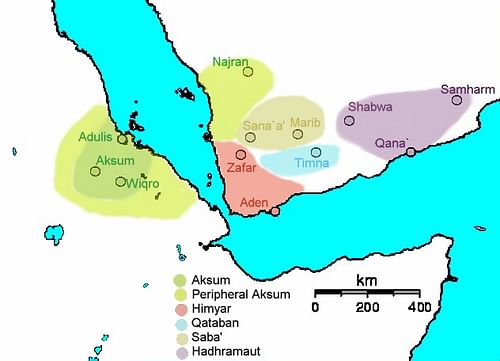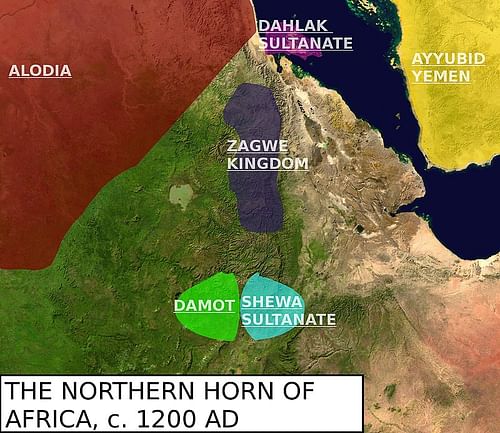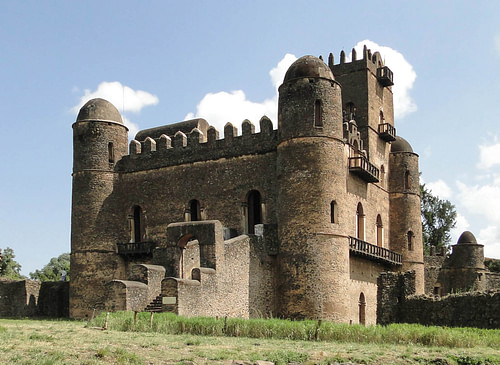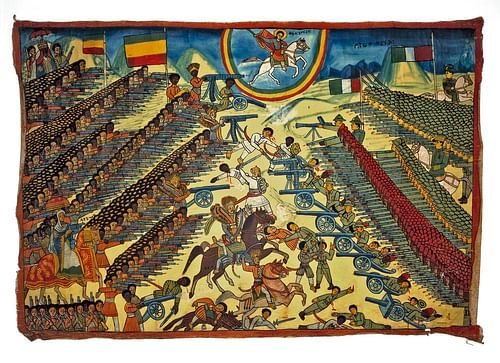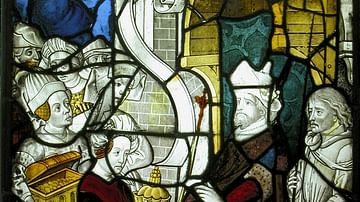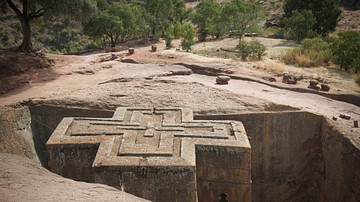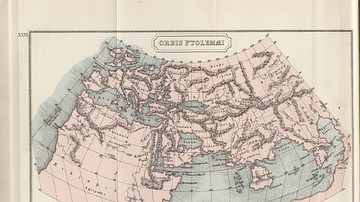The Solomonic Dynasty ruled Ethiopia from the 1270s to the 1970s, and the 14th-century work, the Kebra Nagast (The Glory of the Kings) famously tells of how the dynasty of Ethiopian kings descended from King Solomon himself. The descent from Solomon meant very different things at different times, but the Solomonic succession has remained in the Ethiopian cultural landscape for centuries.
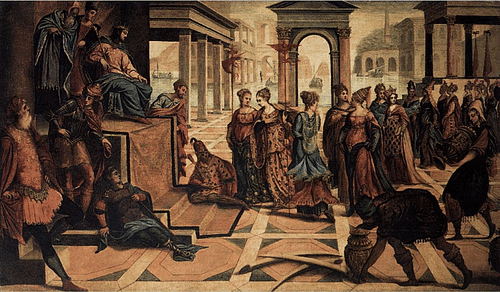
The Kebra Nagast
There has been much speculation over who wrote the Kebra Nagast and when, but all we know for certain is that the compilation of stories was penned sometime in the 1300s. Its name comes from the heading of the first chapter, and it means the "Glory of Kings" in Ge'ez. Ge'ez is the ecclesiastical language of the Ethiopian Church, just as Latin is for the Roman Catholic. What is also unclear is how much of the historical contents reference earlier sources; historians generally agree that it is some but not all.
It all begins with the Queen of Sheba's embassy to King Solomon of Israel, as told in I Kings and II Chronicles of the Old Testament. The Kebra Nagast identifies Sheba with the ancient Kingdom of Aksum, situated in Ethiopia. II Chronicles 9:12 says that "King Solomon gave the queen of Sheba all she desired" and the Kebra Nagast takes that to mean they had a son together. The queen gave birth after she returned home to a son called Menelik. When he grew up, Menelik travelled back to his father, learned the wisdom of Solomon, then returned to his home country, bringing with him the Ark of the Covenant. The Ark has remained a focus for Ethiopian Christian life ever since; purportedly it lies in the Church of Our Lady Mary of Zion in the modern city of Axum and is so important that even the symbolic representations of the tablets within (tabots) must be treated with great reverence and concealed from the eyes of any but the priests.
Menelik went on to rule and have sons of his own, the Kebra Nagast claims, and that is the origin of family ruling Ethiopia at the end of the 13th century. "No one except the male seed of David, the son of Solomon the King", asserts the Queen in the Kebra Nagast, "shall ever reign over Ethiopia" (ch. 87).
Ancient Aksum
Aksum was very significant to medieval Ethiopia's sense of itself. At its height, this ancient kingdom ruled over much of what is now Ethiopia and Eritrea. It may have even extended, at least in influence, over the Red Sea into southern Arabia. The 3rd-century Persian prophet Mani named Aksum one of the four great world civilisations, along with Persia, China and Rome. Missionaries from Roman Egypt successfully converted the rulers to Christianity sometime in the 4th century, and the population followed. There has been a close connection between the Egyptian and Ethiopian churches ever since.
It is not known when Aksum was first associated with Sheba, but they very likely did it themselves. Later Aksumite inscriptions list a title that could be the kingship of Sheba. Perhaps their empire extended to the historical Sheba in southern Arabia. Regardless, the important point is that it offered a plausible way for Ethiopian Christians to fit into the Bible's narrative. Many other Christian cultures associated their histories with events and characters from the Bible, like the English legend that Joseph of Arimathea founded the monastery of Glastonbury.
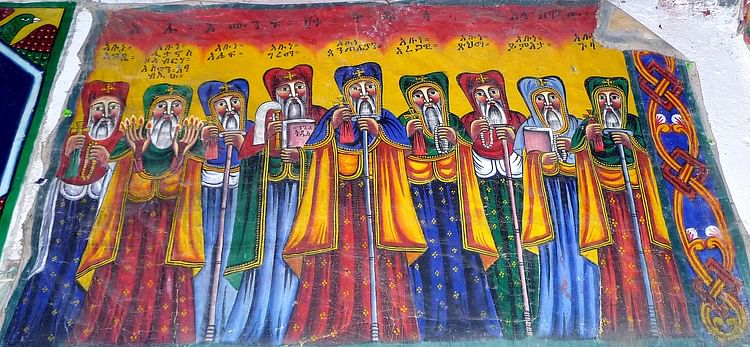
While the Aksumite Empire fell and was nothing more than a memory by the Middle Ages, it was a cherished one for Ethiopian Christians. Monasteries founded in Aksumite times by the Nine Saints – like the famous Debra Damo on its inaccessible plateau – were powerful symbols of identity and continuity of Christian culture. Stories of and links with Aksum were consequently very important.
Medieval Abyssinia
The Christian Zagwe Dynasty emerged in the old heartland of Aksum sometime between 900 and 1137. Between the fall of Aksum and the rise of the Zagwe, Islam had arrived in force across the Red Sea and much of the Horn of Africa was now under the sway of Muslim sultans who spread trading connections with the rest of the world and got rich off the profits. Then there was the Kingdom of Damot, which followed indigenous East African religion. Zagwe kings were thus very keen to promote their distinctive, Christian identity. They had the Lalibela Churches (now a UNESCO World Heritage Site) carved entirely from the rock, for instance. Moreover, they drew heavily upon the heritage of Aksum, and probably also had some version of Solomonic descent.
However, it is their successors who are remembered as the Solomonic dynasty. Yekuno Amlak (r. 1270-1285) rebelled against the Zagwe in 1270. Little is known about the reason, but we do know that Yekuno Amlak was a noble whose power base was in the south, a territory newly conquered for the Christians. Yekuno Amlak and the other southern warlords were Amhara, a Semitic people related to the Arabic ethnic group, while the Zagwe were Agaw, a Cushitic group like the Somalis and even the ancient Egyptians. The new king and his successors soon dominated the region, though the general picture seems to be uneasy coexistence between different religions rather than war motivated by interfaith hatred.
To gain and consolidate this power, Yekuno Amlak needed more than just force of arms: he needed legitimacy. Most historians agree that the Kebra Negast was written to legitimise the rule of his dynasty about 40 years after his death, invoking their true descent from Solomon against the Zagwe pretenders.
He was clearly very successful, at least in retrospect, given the whole period is named after the claim. Ethiopian stories from later times also make reference to it. An 18th-century biography of Yekuno Amlak runs that he was a poor young lad hanging around the palace of the last Zagwe king. That king heard a cock crowing, saying that "whoever eats my head will be rightful king". He, the king, asked the saintly Takla Haymanot (1215-1313) – the founder of Debra Libanos monastery who was worshipped as a saint by the time this was written – to help. Takla Haymanot advised him to eat the head himself, but the cook threw it away when preparing the chicken. Of course, Yekuno Amlak found it and ate it. An angel appeared to Takla Haymanot and told him that this poor boy was the true descendent of Solomon and his legitimate king. Soon after, the Zagwe were overthrown. The story might be fanciful, but the claim to Solomonic ancestry was very important later on.
Interestingly, it was not so important at the time. Solomonic descent was just one of many methods to legitimise the dynasty of Yekuno Amlak. The story quoted from the Kebra Nagast is only one of very many, and many more of them emphasise Aksum much more than Solomon; and, in any case, the Kebra Nagast is not mentioned very much at all in other primary sources. Actions that prove the monarchy is Christian, on the other hand, are common.
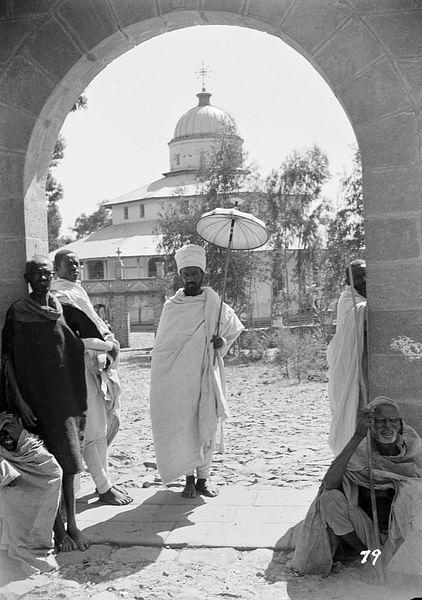
Further, there was no established tradition of succession from father to eldest son. Scholar Sara Marzagora has argued that this descent should be understood as religious rather than literal. The Kings of Abyssinia were not so much the sons of Solomon as the heirs to his kingdom, the New Israel. That was hardly unusual at the time – Saxons, for example, claimed their descent from Isaac. It may be that Solomonic connections were just one way of proving continuity from Aksum and hence connection to the world of the Bible, rather than association with his dynasty.
Modern Ethiopia
150 years after Yekuno Amlak, his dynasty was brought to its knees. A devout Muslim noble called Ahmed ibn Ibrahim (r. 1527-1543), known to history as Gragn, the Left-Handed, split from his sultan, who he saw as decadent and too close to the Christians, to form his own sultanate. From there he ravaged Abyssinia from 1529 to 1543, destroying much of its art, architecture, manuscripts and monasteries. The great Church of Makane-Sellase, apparently entirely covered with gold leaf, was only finished 20 years before Ahmed Gragn's armies demolished it.
Christian Abysinnia was not destroyed, but it was much weakened, retreating to the old heartland of Aksum and Zagwe in the north. In the south, the power vacuum facilitated the Great Oromo Migrations (especially after 1554). The Oromo are another Cushitic group, like the Agaw, and are now the largest population group in Ethiopia, but before the migrations, their homeland was further to the south. Now the Oromo states were major players, too, and kept Abysinnia from expanding again. Meanwhile, the Ottomans and Portuguese Empire had also arrived in the region to fight each other for control of the Red Sea and the wider Indian Ocean trade. Portuguese merchants even supplied weapons and soldiers to help Abyssinia against Ahmed Gragn.
The Solomonic kings consolidated from the mid-1600s and built the great citadel of Gondar, which has been dubbed the 'Camelot of Africa'. Still, they could not return to their old strength, and even that renaissance proved short-lived. Historians of Ethiopia call the 1700s the Zamana Masafent, the Age of Princes, in which the monarchy was little more than a figurehead to whom Abysinnian warlords gave lip-service fealty while raiding and fighting each other. In this age, the aristocracy intermarried extensively, so almost any Abysinnian noble could claim descent from Solomon if they chose. Rivals and pretenders did just that, arguing among themselves for the priority of different lines of descent.
However, everything turned on its head again in the mid-19th century. Tewodros II (r. 1855-68) rose from some of the lowest rungs of the nobility to almost unite the country under his rule. His long-reigning successor-but-one, Menelik II (r. 1889-1913), pushed hard to modernise and expand the Ethiopian state but had to struggle against both internal foes, like the Oromo states he subjugated, and external threats in the form of European empires. Even after Menelik defeated an Italian invasion at the Battle of Adwa in 1896, a monumental triumph still celebrated across Africa, his state remained hemmed in by industrialised, imperial powers.
Both of these men needed to legitimise their rule, both to their own nobility and to the outside world. Menelik in particular had to compete for power with a pretender with a clearer line of descent from Yekuno Amlak and had to persuade European powers that his was not a country that ought to be conquered. Solomonic descent provided a solution to both problems. Menelik pushed the story in the Kebra Nagast to the forefront of his propaganda. Knowing that Europeans would put little credence on the idea of Ethiopia as the spiritual successor of Israel, this time he placed himself as the literal, genealogical successor of King Solomon. He even changed his name to Menelik – he was baptised Sahle Maryam.
Menelik stressed continuity with old Aksum in other ways, too. He funded archaeological digs of Aksumite sites – especially by the Germans, with whom he hoped to ally as a foil against more immediate Italian, French, and British threats – to demonstrate the longevity of Ethiopia's civilisation to the world. This was at a time when most Europeans saw Africa as a primitive tabula rasa which they could settle and 'improve'. Further, Menelik used archaeological expeditions to medieval sites beyond the Amhara heartland to justify his conquests. He argued he was just reconquering what was taken and the remnants of churches proved it.
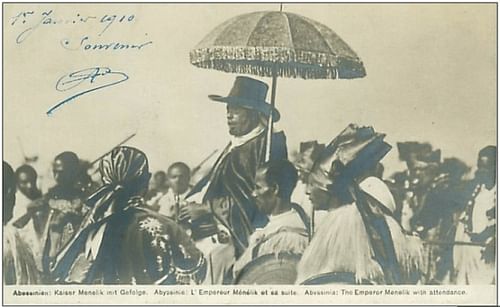
Images and symbols of Solomon were also taken up by Menelik's successor, Haile Selasse (1892-1975), who became de facto ruler shortly after Menelik's death and was crowned in 1930. As emperor, Haile Selasse popularised the story throughout the world and used the arts – like statues, royal paraphernalia, newspapers and popular history – to project the image of an unbroken line of succession, from father to son, from Solomon to himself. Solomonic descent would be a key element of Ethiopian state ideology until the communist takeover of 1974.
